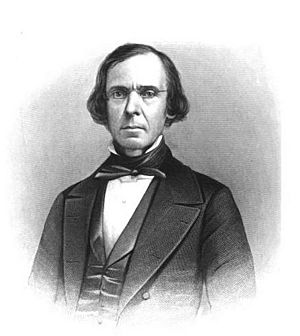Hugh A. Garland facts for kids
Quick facts for kids
Hugh A. Garland
|
|
|---|---|
 |
|
| Born | June 1, 1805 Nelson County, Virginia, U.S.
|
| Died | October 14, 1854 (aged 49) |
| Alma mater | Hampden Sydney College University of Virginia |
| Occupation | Lawyer |
| Political party | Democrat |
| Spouse(s) | Anne Burwell |
| Children | 9 children |
| Relatives | Landon Garland, (brother), James Madison, (great-uncle), Samuel Garland Jr., (nephew) |
| Signature | |
Hugh Alfred Garland (born June 1, 1805 – died October 14, 1854) was an American lawyer and politician. He was also involved in the system of slavery. He served in the Virginia House of Delegates, which is part of Virginia's government. From 1838 to 1841, he worked as the clerk for the United States House of Representatives.
Garland strongly supported slavery, a system where people were forced to work without pay and were considered property. He was a lawyer for the owner of Dred Scott in a very important court case called Dred Scott v. Sandford. This case was about whether Dred Scott, an enslaved man, should be free. However, Hugh Garland died three years before the case was decided by the United States Supreme Court.
Contents
Early Life and Education
Hugh Garland was born on June 1, 1805, in Nelson County, Virginia. His parents were Alexander Spotswood Garland and Lucinda Rose. His great-uncle was James Madison, who was the fourth President of the United States. Hugh Garland was also the brother of Landon Garland and the uncle of Samuel Garland Jr., who became a general in the Confederate Army.
Hugh Garland went to Hampden Sydney College, where he also taught for a short time. While there, he gave a speech about how important a classical education was. Later, he studied law at the University of Virginia.
A Career in Law and Politics
Hugh Garland started his law career in Boydton, Virginia. His brother, Landon Garland, was a professor at Randolph Macon College in the same town. While they lived there, Hugh's wife, Anne Burwell Garland, ran a school for girls. The house where they lived and ran the school is still standing today.
In 1833, Garland was chosen to be a member of the Virginia House of Delegates. This is a group of elected officials who make laws for the state of Virginia.
Serving the U.S. House of Representatives
From 1838 to 1841, Hugh Garland worked as the clerk of the United States House of Representatives. He got this job partly because he strongly supported President Andrew Jackson's ideas about banks. Garland had shown this support when he was in the Virginia legislature. In 1839, he wrote an article defending the Democratic Party in a magazine called the Democratic Review.
In September 1840, Garland spoke at a meeting of Democrats in Groton, Connecticut. During his speech, he spoke against people who wanted to end slavery, known as abolitionists. After this, he became known as a supporter of Southern ideas, even though he was from the North. In 1845, he gave a speech in Petersburg, Virginia, honoring Andrew Jackson.
Moving to St. Louis
Later, Hugh Garland's law practice changed, and he moved to St. Louis, Missouri, in 1847. There, he became a lawyer for the owner of Dred Scott. He and another lawyer, Lyman Decatur Norris, were hired by Irene Emerson, who was the owner of Dred Scott.
In 1850, records show that Hugh Garland owned ten enslaved people in Missouri. His wife, Anne Burwell Garland, also owned an enslaved woman named Elizabeth Keckley. After Hugh Garland died, his wife freed Elizabeth Keckley and her son in 1855 for $1200. Elizabeth Keckley later became a close friend of Mary Todd Lincoln, who was the wife of President Abraham Lincoln. Elizabeth Keckley also wrote a book about her life.
Hugh Garland is also remembered for writing a two-volume book about John Randolph of Roanoke. He also published another book called Protestantism and Government in 1852.
Death and Family Legacy
Hugh Garland died suddenly in St. Louis on October 14, 1854. He was 49 years old.
Garland's son, Hugh Alfred Garland Jr. (1837-1864), became a colonel in the Confederate States Army during the American Civil War. He died in 1864 during the Battle of Franklin.

